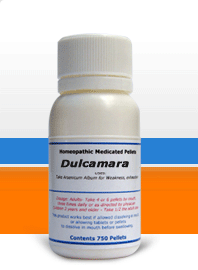Dulcamara is prepared from a plant which grows abundantly
in the continents of Europe and America. Its branches are quite long and spread
out, bearing purple coloured flowers. Its stem and roots make the mouth bitter
when chewed, but later on there is a sweet after-taste in the mouth. That is
the reason why it is called bitter sweet. The homoeopathic medicine prepared
from the extract of the fresh plant is called Dulcamara.
The main function of Dulcamara is on the inner linings (i.e.
the mucous membranes). The most salient point is that any kind
of sudden change of weather, from hot to cold or from cold to
hot, from moist to dry and vice versa, affects the mucous membranes of
the body, especially when the change is very prompt and sudden.
For this kind of condition, Dulcamara would probably be the most
appropriate treatment. The common
cold spreads far and wide during a change of
weather. Dulcamara would certainly be useful to treat a patient who
catches a cold with every change of weather, even if the other symptoms of the
patient do not give a clear picture. After
a vigorous game, some players change their clothes while the body is still hot.
They develop nasal catarrh. Similarly, sudden exposure to hot weather from a
cold situation also causes a cold. The symptoms get worse at night and on
resting. The catarrhal changes can affect the kidneys, the intestines as well
as the stomach, leading to frequent urination and the onset of diarrhoea, the
reason being the same (i.e. irritation of the mucous linings of these organs).
The symptoms aggravate in moist climate and wet weather. If during summer a person contracts cold
while visiting hill stations or coming back from the hill stations, Dulcamara
would certainly be the indicated treatment. Some people develop dysentery instead of diarrhoea on
exposure to cold. This type of dysentery would also be amenable to
Dulcamara. Dulcamara given in high potency works as a sure preventive measure,
so much so that sudden changes in weather would not affect such patients at
all.
Dulcamara will also be useful in treating the symptoms
which result from suppression of sweating on entry into a cold place. The cold due to Dulcamara starts at the nose
and settles in the eyes. The eyes become heavy and
discharge yellowish liquid. The secretion is thin like water. The eyelids get
swollen as well. If not treated adequately with Dulcamara, the cold becomes
chronic. In Dulcamara, the cold
is usually of dry nature, associated with blockage of the nose. The
thick yellow secretion sticks in the nose.
The nasal catarrh returns on exposure to even the slightest cold. The nose
also bleeds.
Dulcamara is also the treatment for chronic ulcers of the
inner linings (mucous membranes), as well as of the skin. The eczema like lesions develop
on the skin of the face, which then spread rapidly and get covered with yellow
scabs. Clusters of blisters develop and spread widely. The similar symptom is
well seen in Arsenic also, though their nature is different. In Arsenic, the
wounds can progress to the formation of gangrene,
although there is no such tendency in Dulcamara. Dulcamara results in the
formation of ulcers over the superficial bones, which are separated from the
outside only by skin e.g., Shin bone. Regarding the wounds and sores of Arsenic
and Dulcamara, the difference is that in Arsenic, there is formation of lumps
similar to those found in plague. The glands
in the armpits (axilla) also enlarge and pus forms in them. In
Dulcamara, the enlargement of the glands does not lead to the formation of pus.
They only get hardened.In Dulcamara, scabs
form over the scalp which can weep at the edges. This symptom is
also found in Mezereum however, in Mezerum the eczema-type of lesion gets
covered with a membranelike structure. Under this structure, there is formation
of pus, which obviously smells foul. In Dulcamara, the symptoms are not as
severe and progressive.
The other remedies that produce eczema like signs are
Sepia, Arsenic, Graphites, Petroleum, Sulphur, Calcaria salts and Rhus Tox. All
these will have to be distinguished on the basis of their peculiar symptoms.
Croton, Anagalis and Anacardium may also be very useful in
treating such conditions. The eczematous
lesions of Anagalis, Croton and Rhus Tox are mostly on the lower part of the body and around the thighs,
while in Anacardium, the eczema
affects the entire body In Dulcamara, the headache gets worse in the cold and wet
weather. The patient feels light
headed. The head is heavy, and there is pain
on the temple areas. The ears
ache and buzz, affecting the capability to hear. The glands around
the ears become inflamed. The cheeks hurt badly and the pain spreads towards
the ears, eyes and jaws. The tongue becomes dry and rough. Paralysis of the
tongue is also prominent. The neuralgic pain on the face as described gets worse
on exposure to cold.
The patient hates food. There is a non-ending urge to
drink water. There is burning in the
stomach, along with the tendency for nausea
and vomiting. The vomiting contains white sticky secretions. During the
act of vomiting, the patient feels very cold. On exposure to cold, the bladder becomes inflamed and
irritable, leading to frequent urination. There is a constant desire
to pass urine which comes in drops.
The ailments of Dulcamara are relieved by lying on the
side, but become aggravated on lying on the back or bending forwards. Movement ameliorates the symptoms, which
increase in the evening and at night. The symptoms also get worse during the
change of weather or on getting wet in humid weather or taking cold beverages, etc.





